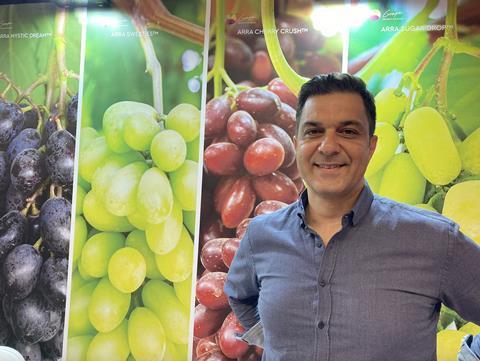With Southern Hemisphere grape volumes increasingly impacted by rain, and strong demand coming from South America, the US and Asia, the European market is increasingly under pressure, says Georgios Bitsakos from Grapa Varieties
Greek producer, packer and exporter Katsagiotis has revealed that it is expanding production of grapes in Greece, and according to Georgios Bitsakos, head of brand marketing for the Arra varieties, the move makes a lot of sense, while illustrating the importance of Greek grapes for Europe.
“Katsagiotis are strong in Arra varieties,” he says. “They have Arra Sweeties and have bold plans to expand with Cherry Crush, a beautiful crunchy, red variety. Their aim is to go to the end of the season with the rain-resistant Arra Cherry Crush and the rain-tolerant Arra Fire Crunch, which comes a bit earlier.”

There are three main production regions for Greek grapes, Bitsakos explains: Crete, Corinth and Macedonia. “The main problem in Crete is the heat, while the issue in Corinth is the lack of water,” he says. “The eastern part of the Peloponnese receives very little rainfall, and last July there were 12 days above 40C, which destroyed everything.
“Producers in the north like Katsagiotis had a good season last year. There was no lack of water, and it was a bit warmer, which is good for the grapes, so they had an extended season toward the end. Greece is important as a grape producer because it is the latest European country to harvest, and that means you can delay shipping grapes from Brazil and Peru, which is much more expensive.”
Brazil’s first semester production, harvested from March to April, has been hit by excessive rain this season, with exports to Europe already diminished due to strong demand from the local Brazilian market, as well as from neighbouring countries and the US. But again, due to their resistance to rain, Arra Sweeties and Arra Cherry Crush were the varieties that ensured good returns to the growers in Brazil.”
“Now Europe is not the most premium market as it might have been in the past,” says Bitsakos. “Last year, after Storm Hilary, a box of grapes reached US$38. Europe cannot pay that sort of price. The UK imports grapes 12 months a year and pays better money than continental Europe, so the UK may be in a better position. But the US, and increasingly Asia now for the Southern Hemisphere seasons, are big competitors for Europe. During the winter months, they can pay better prices.”
Meanwhile, the Californian grape season is late this year, due to cold, wet spring conditions, Bitsakos says. “There was snow in the mountains and 10C in early April, and also rain, so the season is going to be late,” he explains.
“This spring we saw quite promising results for the new Arra Red Selection trials in India and we are interested in organising tasting panels, with samples to retailers key destination markets,” he says. “The grapes are grown in the Maharashtra region, where the Arra programme started in 2018, becoming the first breeder to go to India. We work exclusively with Sahyadri Farms, a big company with thousands of growers around them. So far, they work massively with Arra Sweeties and will now continue with the Red Selection trials, which may hopefully be a breakthrough because India is only known for white rather than red grapes.”



